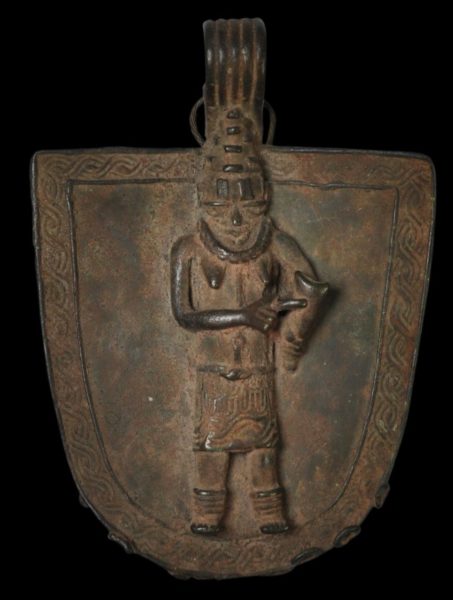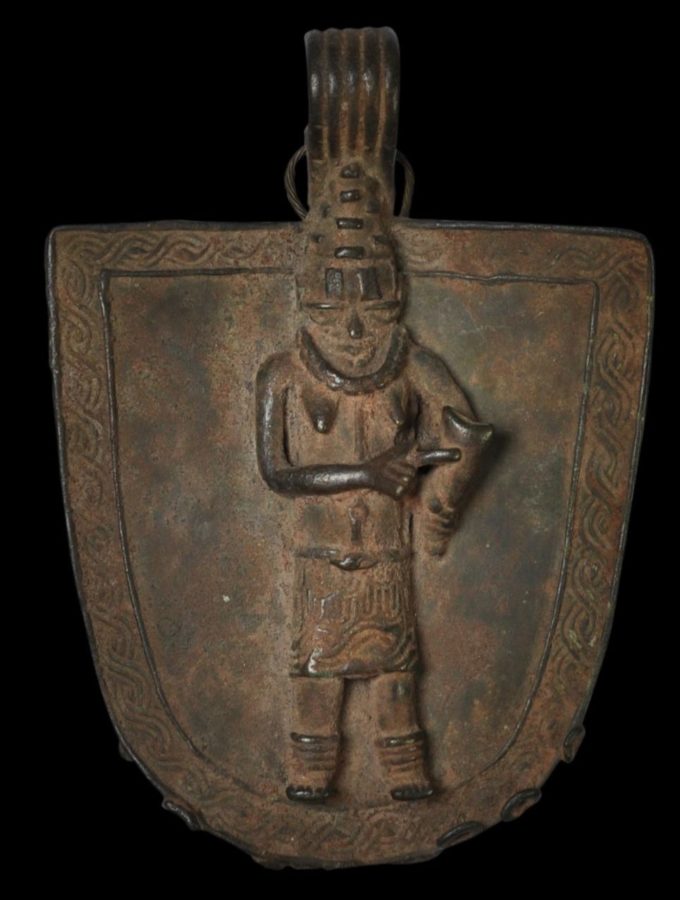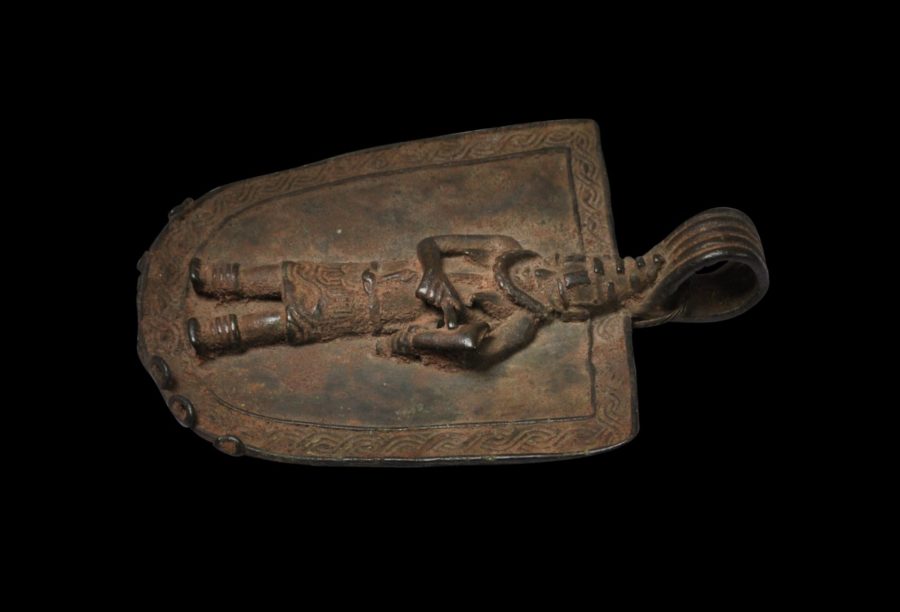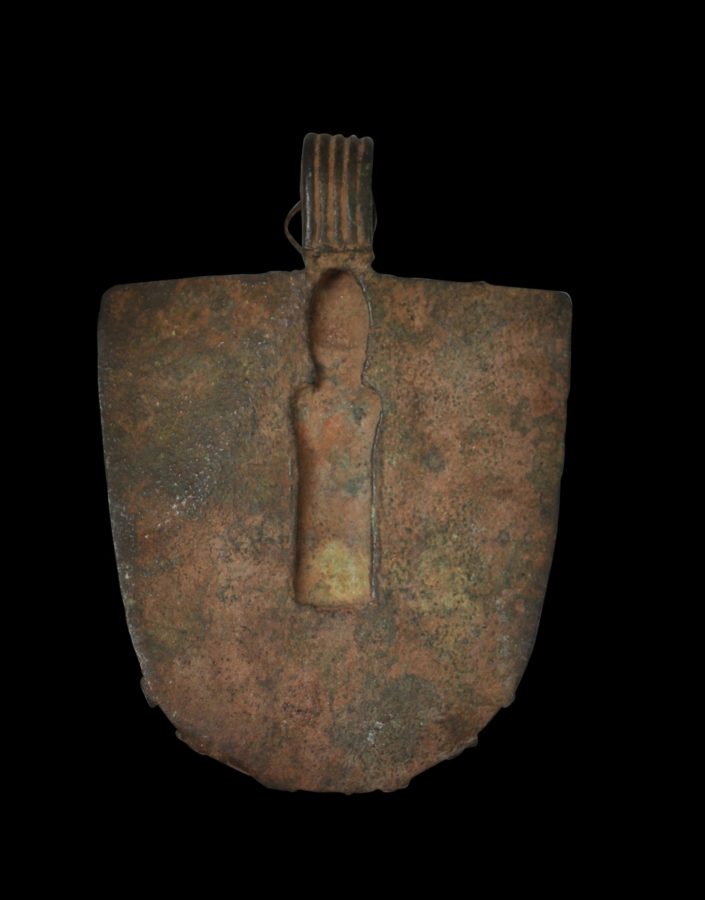The plaque of semi-circular or spade form has been cast in high relief with a senior female (possibly even a queen mother – Iyoba – the mother of the ruler – oba) wearing a high, pointed coral headdress and necklace, as well as a loin cloth and anklets, and with what is likely to be a badge of rank on her chest. She is striking a sistrum with a rod.
The plaque has been cast with a border of fine, interlaced scrolling motifs.
The top of the plaque has been cast with a broad, ribbed loop.
The outer edge retains remnants of what would have been a row of eyelets possibly from which crotals (small, hollow bronze bells or rattles) might have been suspended.
The reverse shows the cavity for the figure on the front, in keeping with other similar plaques of this period.
Such plaques were likely to have been worn as belt ornaments.
The plaque has a pronounced reddish tinge on account of having a high copper content. This is in keeping with other Benin cast brass items that date to around the 16th century. Successively less copper was used over the next 300 years of bronze production in Benin, so that as such items get later and later, they become less red, ‘brassier’ or darker (Plankensteiner, 1997, p. 193).
A plaque or aegis with a very similar theme of a highly-ranked, coral-clad female beating a sistrum with a rod which was seized during the Benin Punitive Expedition of 1897 (launched by the British against Benin’s traditional ruler) and is now in the Pitt-Rivers Museum, Oxford. The piece is illustrated in Pitt-Rivers (1976, plate 38).
Examples of such plaques are in the British Museum here and here.
Also, for other pendant plaques or aegis see Pitt-Rivers (1976, plates 19, 32, 36 & 38); (Plankensteiner, 1997, p. 366-67); Duchâteau (1994, p. 82) and Dark (1973, pl. 23).
The plaque is in fine condition given its age. A past owner has attached an old loop of twisted wire to the main loop to allow the plaque to be suspended. We have chosen to keep this in place (though it could be removed easily) simply because even this wire has obvious age and patina.
Overall, this is a superb piece.
Benin
The Kingdom of Benin Empire was a pre-colonial African state in what is now modern Nigeria. (Essentially, the entity no longer exists, having been subsumed into what is Nigeria. Nor is it to be confused with the modern-day country called Benin.)
The Edo people were the founders of what became the Kingdom of Benin. Their ruler styled himself as the first Oba and his city became what the Portuguese called Benin City in the 1400s.
The Oba became the paramount power within the region. Oba Ewuare, who became known as the first ‘Golden Age’ Oba, is credited with turning Benin City into a fortified military centre protected by moats and walls. It was from this bastion that he launched his military expansion of the kingdom beyond the Edo-speaking heartlands.
Portuguese explorers were the first European travellers to reach Benin in about 1485. A strong trading relationship evolved. The Edo traded tropical products such as ivory, pepper and palm oil with the Portuguese for European goods such as forged metal and guns. The Oba and the Portuguese king exchanged ambassadors in the sixteenth century.
European visitors to Benin City in the 16th and 17th centuries brought back tales of a fabulous city of impressive public buildings, ruled over by a powerful king. English envoys were particularly impressed but the Oba soon suspected the English of having colonial designs on his kingdom.
The Oba’s position was both a religious and political one. He needed the active participation of court officials in order to fulfil his ritualistic and mystical obligations. Their ability to refuse served as a means of modifying an oba’s tyrannical tendencies. The Oba was not seen as a god but his office was deemed holy. He was the living representative of his deceased ancestors and as such was deemed to have supernatural powers. Accordingly, much was done to conceal the ‘ordinariness’ of the Oba from his people: no-one outside the palace was permitted to see him eat or sleep for example. Indeed, the Oba rarely left the palace – just once or twice a year.
The Kingdom’s fortunes waned after 1700 as tribal wars and changing economic circumstances took their toll but then revived in the nineteenth century as textile and palm oil exports increased.
The British pressured the Oba to sign a protectorate treaty with Britain through most of the 1880s and 1890s. A treaty that placed Benin under the jurisdiction of British consular officials, permitted the presence of Christian missionaries and opened Benin to free trade was signed by the Oba in 1892, but the Oba essentially ignored the tenets of the treaty thereafter.
As the colonial nature of Britain’s overtures became clearer, relations deteriorated culminating in eight representatives from Britain being murdered in Benin in early 1897. The British launched a punitive expedition – the Benin Expedition – later that year. The British force under the command of Admiral Sir Harry Rawson, razed and burned Benin City.
Monuments and palaces of many nobles and chiefs were looted and destroyed, and on the third day the looted Benin king’s palace was deliberately set ablaze. The Iyoba’s palace also was raided and destroyed.
Much of the city’s artwork and heritage was destroyed and what remained particularly the royal bronzes and ivories, was taken from Benin and dispersed among private collectors and museums in Europe.
It is quite possible, likely even, that the plaque here was taken from Benin during the Punitive Expedition.
References
Dark, P. J. C., An Introduction to Benin Art and Technology, Oxford University Press, 1973.
Duchâteau, A., Benin: Royal Art of Africa from the Museum für Völkerkunde Vienna, Prestel, 1994.
Pitt-Rivers, A., Antique Works of Art from Benin, Dover Publications, 1976.
Plankensteiner, B., Benin Kings and Rituals: Court Arts from Nigeria, Snoeck Publishers, 2007.





